常用sql语句及案例
目录
1)基本
2)数学函数
3)rownum
4)分页
5)时间处理
6)字符函数
7)to_number
8)聚合函数
9)学生选课
10)图书馆借阅
基本
--新建表:
create table table1( id varchar(300) primary key, name varchar(200) not null); --插入数据
insert into table1 (id,name) values ('aa','bb'); --更新数据
update table1 set id = 'bb' where id='cc'; --删除数据
delete from table1 where id ='cc'; --删除表
drop table table1; --修改表名:
alter table table1 rename to table2; --表数据复制:
insert into table1 (select * from table2); --复制表结构:
create table table1 select * from table2 where 1>1; --复制表结构和数据:
create table table1 select * from table2; --复制指定字段:
create table table1 as select id, name from table2 where 1>1; --条件查询:
select id,name (case gender when 0 then '男' when 1 then ‘女’ end ) gender from table1
数学函数
--绝对值:abs()
select abs(-2) value from dual; --取整函数(大):ceil()
select ceil(-2.001) value from dual; --(-2) --取整函数(小):floor()
select floor(-2.001) value from dual; --(-3) --取整函数(截取):trunc()
select trunc(-2.001) value from dual; -- (-2) --四舍五入:round()
select round(1.234564) value from dual; --(1.2346) --取平方:Power(m,n)
select power(4,2) value from dual; --(16) --取平方根:SQRT()
select sqrt(16) value from dual; --(4) --取随机数:dbms_random(minvalue,maxvalue)
select sys.dbms.random.value(0,1) value from dual; --取符号:Sign()
select sign(-3) value from dual; --(-) --取集合的最大值:greatest(value)
select greatest(-1,3,5,7,9) value from dual; --(9) --取集合的最小值:least(value)
select least(-1,3,5,7,9) value from dual; --(-1) --处理Null值:nvl(空值,代替值)
select nvl(null,10) value from dual; --(10)
select nvl(score,10) score from student;
rownum相关
--rownum小于某个数时可以直接作为查询条件(注意oracle不支持select top)
select * from student where rownum <3; --查询rownum大于某个数值,需要使用子查询,并且rownum需要有别名
select * from(select rownum rn ,id,name from student) where rn>2;
select * from (select rownum rn, student.* from student) where rn >3; --区间查询
select * from (select rownum rn, student.* from student) where rn >3 and rn<6; --排序+前n条
select * from (select rownum rn, t.* from ( select d.* from DJDRUVER d order by drivernumber)t )p where p.rn<10; --排序+区间查询1
select * from (select rownum rn, t.* from ( select d.* from DJDRIVER d order by DJDRIVER_DRIVERTIMES)t )p where p.rn<9 and p.rn>6; --排序+区间查询2
select * from (select rownum rn, t.* from ( select d.* from DJDRIVER d order by DJDRIVER_DRIVERTIMES)t where rownum<9 )p where p.rn>6;--效率远高于方式一
分页查询
(假设每页显示10条)
不包含排序:
--效率低 select * from (select rownum rn, d.* from DJDRIVER d )p where p.rn<=20 and p.rn>=10;
select * from (select rownum rn, d.* from DJDRIVER d )p where p.rn between 10 and 20; --效率高 select * from (select rownum rn, d.* from DJDRIVER d where rownum<=20 )p where p.rn>=10;
包含排序:
--排序+区间查询1(效率低)
select * from (select rownum rn, t.* from ( select d.* from DJDRIVER d order by DJDRIVER_DRIVERTIMES)t )p where p.rn<=20 and p.rn>=10;
select * from (select rownum rn, t.* from ( select d.* from DJDRIVER d order by DJDRIVER_DRIVERTIMES)t )p where p.rn between 10 and 20; --排序+区间查询2(效率高)
select * from (select rownum rn, t.* from ( select d.* from DJDRIVER d order by DJDRIVER_DRIVERTIMES)t where rownum<=20 )p where p.rn>=10;
时间处理
1. to_char和to_date基本使用
--日期
--年 yyyy yyy yy year
--月 month mm mon month
--日+星期 dd ddd(一年中第几天) dy day
--小时 hh hh24
--分 mi
--秒 ss
eg1:
select to_char(sysdate,'yyyy-mm-dd hh24:mi:ss')currenttime,
to_char(sysdate,'yyyy') year,
to_char(sysdate,'mm') month,
to_char(sysdate,'dd') day,
to_char(sysdate,'day') week,
to_char(sysdate,'hh24')hour,
to_char(sysdate,'mi') minute,
to_char(sysdate,'ss') second
from dual;

eg2:
select to_date('2009-07-04 05:02:01','yyyy-mm-dd hh24:mi:ss')currenttime,
to_char(to_date('2009-07-04 05:02:01','yyyy-mm-dd hh24:mi:ss'),'yyyy')year,
to_char(to_date('2009-07-04 05:02:01','yyyy-mm-dd hh24:mi:ss'),'mm')month,
to_char(to_date('2009-07-04 05:02:01','yyyy-mm-dd hh24:mi:ss'),'dd') day,
to_char(to_date('2009-07-04 05:02:01','yyyy-mm-dd hh24:mi:ss'),'day') week,
to_char(to_date('2009-07-04 05:02:01','yyyy-mm-dd hh24:mi:ss'),'day','NLS_DATE_LANGUAGE=American') week, --设置语言
to_char(to_date('2009-07-04 05:02:01','yyyy-mm-dd hh24:mi:ss'),'hh24')hour,
to_char(to_date('2009-07-04 05:02:01','yyyy-mm-dd hh24:mi:ss'),'mi') minute,
to_char(to_date('2009-07-04 05:02:01','yyyy-mm-dd hh24:mi:ss'),'ss') second
from dual;

2)months_between
select months_between(to_date('03-31-2014','MM-DD-YYYY'),to_date('12-31-2013','MM-DD-YYYY')) "MONTHS"
FROM DUAL;

3)next_day
select sysdate today, next_day(sysdate,6) nextweek from dual;

4)时间区间
eg:
select cardid, borrowdate from borrow where to_date(borrowdate,'yyyy-mm-dd hh24:mi:ss') between
to_date('2014-02-01 00:00:00','yyyy-mm-dd hh24:mi:ss') and
to_date('2014-05-01 00:00:00','yyyy-mm-dd hh24:mi:ss');
5)interval
select to_char(sysdate,'yyyy-mm-dd hh24:mi:ss') currenttime,
to_char(sysdate - interval '7' year,'yyyy-mm-dd hh24:mi:ss') intervalyear,
to_char(sysdate - interval '7' month,'yyyy-mm-dd hh24:mi:ss') intervalMonth,
to_char(sysdate - interval '7' day,'yyyy-mm-dd hh24:mi:ss') intervalday,
to_char(sysdate - interval '7' hour,'yyyy-mm-dd hh24:mi:ss') intervalHour,
to_char(sysdate - interval '7' minute,'yyyy-mm-dd hh24:mi:ss') intervalMinute,
to_char(sysdate - interval '7' second,'yyyy-mm-dd hh24:mi:ss') intervalSecond
from dual;

6)add_months
select add_months(sysdate,12) newtime from dual;
7)extract
select extract(month from sysdate) "This Month",
extract(year from add_months(sysdate,36)) " Years" from dual;

字符函数
--字符函数
select substr('abcdefg',1,5)substr, --字符串截取
instr('abcdefg','bc') instr, --查找子串 'Hello'||'World' concat, --连接 trim(' wish ') trim, --去前后空格
rtrim('wish ') rtrim, --去后面空格
ltrim(' wish') ltrim, --去前面空格 trim(leading 'w' from 'wish') deleteprefix, --去前缀
trim(trailing 'h' from 'wish') deletetrailing, --去后缀
trim('w' from 'wish') trim1, ascii('A') A1,
ascii('a') A2, --ascii(转换为对应的十进制数)
chr(65) C1,
chr(97) C2, --chr(十进制转对应字符) length('abcdefg') len, --length lower('WISH')lower,
upper('wish')upper,
initcap('wish')initcap, --大小写变换 replace('wish1','1','youhappy') replace, --替换 translate('wish1','1','y')translate, --转换,对应一位(前面的位数大于等于后面的位数)
translate('wish1','sh1','hy')translate1, concat('11','22') concat --连接 from dual;

to_number
--to_number(expr)
--to_number(expr,format)
--to_number(expr,format,'nls-param') select to_number('0123')number1, --converts a string to number
trunc(to_number('0123.123'),2) number2,
to_number('120.11','999.99') number3,
to_number('0a','xx') number4, --converts a hex number to decimal
to_number(100000,'xxxxxx') number5
from dual;

聚合函数
student表如下:
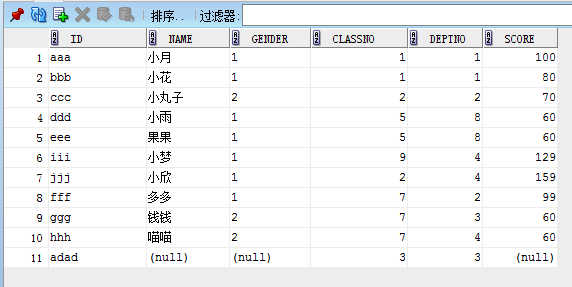
count:
--count (distinct|all)
select count(1) as count from student;--效率最高
select count(*) as count from student;
select count(distinct score) from student;
语句1结果:11
avg
--avg (distinct|all)
select avg(score) score from student;
select avg(distinct score) from student;
select classno,avg(score) score from student group by classno;
语句3输出结果:
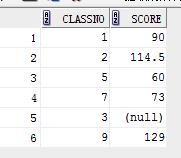
max
--max (distinct|all)
select max(score) from student;
select classno, max(score) score from student group by classno;
min
--min (distinct|all)
select min(score) from student;
select classno, min(score) score from student group by classno;
stddev(standard deviation)标准差
--stddev
select stddev(score) from student;
select classno, stddev(score) score from student group by classno;
sum
--sum
select sum(score) from student;
select classno, sum(score) score from student group by classno;
median--中位数
--median
select median(score) from student;
select classno, median(score) score from student group by classno;
案例1--学生选课
1. 创建表 stu(学生表),course(课程表),选课表(s_c)
--创建表 create table STU
(
id NUMBER not null,
name VARCHAR2(255)
) ; create table COURSE
(
id NUMBER not null,
coursename VARCHAR2(255)
) ; create table S_C
(
sid NUMBER,
cid NUMBER,
score NUMBER
);
2.插入数据
--插入数据
Insert into STU (ID,NAME) values (1,'wish');
Insert into STU (ID,NAME) values (2,'rain');
Insert into STU (ID,NAME) values (3,'july');
Insert into STU (ID,NAME) values (4,'joey'); Insert into COURSE (ID,COURSENAME) values (1,'math');
Insert into COURSE (ID,COURSENAME) values (2,'english');
Insert into COURSE (ID,COURSENAME) values (3,'Japanese');
Insert into COURSE (ID,COURSENAME) values (4,'chinese'); Insert into S_C (SID,CID,SCORE) values (1,1,80);
Insert into S_C (SID,CID,SCORE) values (1,2,90);
Insert into S_C (SID,CID,SCORE) values (2,4,100);
Insert into S_C (SID,CID,SCORE) values (4,4,90);
Insert into S_C (SID,CID,SCORE) values (4,1,100);
Insert into S_C (SID,CID,SCORE) values (4,3,80);
Insert into S_C (SID,CID,SCORE) values (4,2,80);
Insert into S_C (SID,CID,SCORE) values (2,1,90);
Insert into S_C (SID,CID,SCORE) values (2,4,100);
Insert into S_C (SID,CID,SCORE) values (3,1,60);
3.查询学生选课情况
with vt as
(select s.id,s.name,c.coursename,sc.score from stu s, course c, s_c sc where s.id=sc.sid and c.id=sc.cid)
select * from vt order by id;
结果:

案例2--图书馆借阅
1.创建表: 图书(book),读者(reader),借阅(borrow)
--创建表 book
create table book(
bookId varchar2(30), --图书总编号
sortid varchar2(30), --分类号
bookname varchar2(100), --书名
author varchar2(30), --作者
publisher varchar2(100),--出版单位
price number(6,2) --价格
); --创建表 reader
create table reader (
cardId varchar2(30), --借书证号
org varchar2(100), --单位
name varchar2(100), --姓名
gender varchar2(2), --性别
title varchar2(30), --职称
address varchar2(100) --地址
); --创建表 borrow
create table borrow(
cardId varchar2(30), --借书证号
bookId varchar2(30), --图书总编号
borrowDate varchar2(30) --借阅时间
);
2.插入数据
--插入数据-book
insert into book (bookId,sortid,bookname,author,publisher,price)
values ('aaa','a1','gone with the wind','CA','renmin','103'); insert into book (bookId,sortid,bookname,author,publisher,price)
values ('bbb','a2','the little prince','CB','jixie','30'); insert into book (bookId,sortid,bookname,author,publisher,price)
values ('ccc','a3','the ordinary world','CC','renmin','130'); insert into book (bookId,sortid,bookname,author,publisher,price)
values ('ddd','a4','the little women','CA','dianzi','110'); --插入数据-reader
insert into reader(cardid, org, name,gender, title, address)
values ('xxx','A','wish','1','student','bupt'); insert into reader(cardid, org, name,gender, title, address)
values ('uuu','A','luna','1','student','bupt'); insert into reader(cardid, org, name,gender, title, address)
values ('vvv','B','harry','1','student','bupt'); insert into reader(cardid, org, name,gender, title, address)
values ('www','C','chander','2','professor','bupt'); insert into reader(cardid, org, name,gender, title, address)
values ('yyy','A','joey','2','student','bupt'); insert into reader(cardid, org, name,gender, title, address)
values ('zzz','B','richard','2','student','bupt'); insert into reader(cardid, org, name,gender, title, address)
values ('OOO','A','micheal','2','student','bupt'); insert into reader(cardid, org, name,gender, title, address)
values ('ppp','A','richal','2','student','bupt'); insert into reader(cardid, org, name,gender, title, address)
values ('abp','A','michal','2','student','bupt'); insert into reader(cardid, org, name,gender, title, address)
values ('ccp','A','mike','2','student','bupt'); --插入数据-borrow
insert into borrow(cardid,bookid,borrowdate) values('xxx','aaa','2014-4-29');
insert into borrow(cardid,bookid,borrowdate) values('xxx','bbb','2014-4-29');
insert into borrow(cardid,bookid,borrowdate) values('xxx','ccc','2014-4-28');
insert into borrow(cardid,bookid,borrowdate) values('yyy','ccc','2014-4-28');
insert into borrow(cardid,bookid,borrowdate) values('yyy','ddd','2014-4-27');
insert into borrow(cardid,bookid,borrowdate) values('yyy','aaa','2014-4-27');
insert into borrow(cardid,bookid,borrowdate) values('zzz','bbb','2014-4-28');
insert into borrow(cardid,bookid,borrowdate) values('zzz','ddd','2014-4-27');
insert into borrow(cardid,bookid,borrowdate) values('zzz','aaa','2014-4-27');
insert into borrow(cardid,bookid,borrowdate) values('uuu','bbb','2014-4-28');
insert into borrow(cardid,bookid,borrowdate) values('uuu','ddd','2014-4-27');
insert into borrow(cardid,bookid,borrowdate) values('uuu','aaa','2014-4-27');
insert into borrow(cardid,bookid,borrowdate) values('uuu','ccc','2014-4-26');
insert into borrow(cardid,bookid,borrowdate) values('vvv','bbb','2014-4-28');
insert into borrow(cardid,bookid,borrowdate) values('vvv','ddd','2014-4-27');
insert into borrow(cardid,bookid,borrowdate) values('www','aaa','2014-4-27');
insert into borrow(cardid,bookid,borrowdate) values('www','ccc','2014-4-26');
表信息如下:
book------> reader-------> borrow

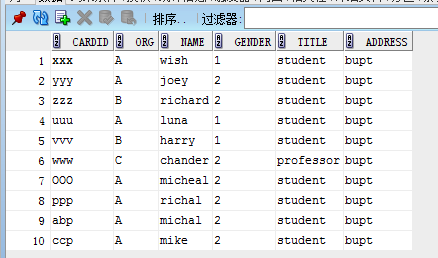
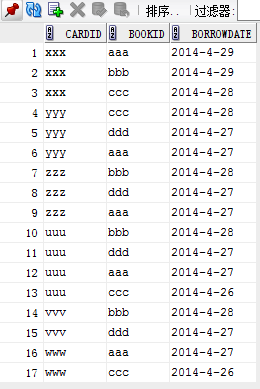
3. 查询A单位借阅图书的读者人数和人员详细信息
人数:
with vt1 as
(select cardid from reader where reader.org='A')
select count(1) from vt1 where exists (select cardid from borrow where borrow.cardid=vt1.cardid);

详细信息:
with vt1 as
(select cardid,name,org from reader where reader.org='A')
select cardid,name,org from vt1 where exists (select cardid from borrow where borrow.cardid=vt1.cardid);
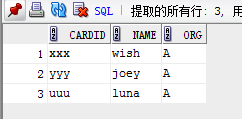
4.查询借书证号尾字符为'p'的读者
select cardid, name, org from reader where cardid like '%p';
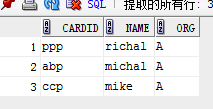
5. 查询名字以m开头的女性读者,‘1’显示为女,‘2’显示为男
select cardid, name, org,
case when gender='1' then '女' when gender='2' then '男' else '其他' end gender
from reader where name like 'm%';
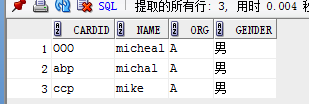
6. 2014年2-4月借过书的读者
1)查询满足条件的读者(仅包含cardid)--未去重
方式一:
select cardid, borrowdate from borrow where to_char(to_date(borrowdate,'yyyy-mm-dd'),'yyyy')='2014'
and to_char(to_date(borrowdate,'yyyy-mm-dd'),'mm')>='02'
and to_char(to_date(borrowdate,'yyyy-mm-dd'),'mm')<='04';
方式二:
select cardid, borrowdate from borrow where to_char(to_date(borrowdate,'yyyy-mm-dd'),'yyyy')='2014' --查询
and to_char(to_date(borrowdate,'yyyy-mm-dd'),'yyyy-mm')>='2014-02'
and to_char(to_date(borrowdate,'yyyy-mm-dd'),'yyyy-mm')<='2014-04';
方式三:
select cardid, borrowdate from borrow where to_date(borrowdate,'yyyy-mm-dd hh24:mi:ss') between
to_date('2014-02-01 00:00:00','yyyy-mm-dd hh24:mi:ss') and
to_date('2014-05-01 00:00:00','yyyy-mm-dd hh24:mi:ss');
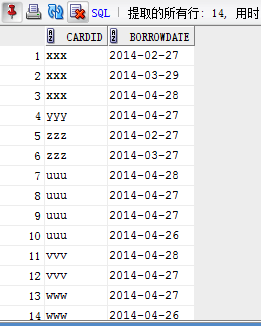
2) 查询+去重
select distinct cardid from borrow where to_char(to_date(borrowdate,'yyyy-mm-dd'),'yyyy')='2014' --查询+去重
and to_char(to_date(borrowdate,'yyyy-mm-dd'),'yyyy-mm')>='2014-02'
and to_char(to_date(borrowdate,'yyyy-mm-dd'),'yyyy-mm')<='2014-04';
select distinct cardid from borrow where to_date(borrowdate,'yyyy-mm-dd hh24:mi:ss') between
to_date('2014-02-01 00:00:00','yyyy-mm-dd hh24:mi:ss') and
to_date('2014-05-01 00:00:00','yyyy-mm-dd hh24:mi:ss');
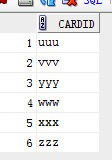
3)查询+去重+读者姓名等信息
with vt1 as
(select distinct cardid from borrow where to_char(to_date(borrowdate,'yyyy-mm-dd'),'yyyy')='2014'
and to_char(to_date(borrowdate,'yyyy-mm-dd'),'yyyy-mm')>='2014-02'
and to_char(to_date(borrowdate,'yyyy-mm-dd'),'yyyy-mm')<='2014-04')
select cardid, name,org from reader where exists (select cardid from vt1 where vt1.cardid=reader.cardid);
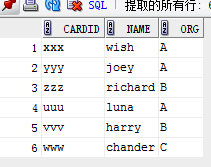
常用sql语句及案例的更多相关文章
- 常用sql语句及案例(oracle)
目录 1)基本 2)数学函数 3)rownum 4)分页 5)时间处理 6)字符函数 7)to_number 8)聚合函数 9)学生选课 10)图书馆借阅 基本 --新建表: ) ) not null ...
- 常用SQL语句大全
一些常用SQL语句大全 一.基础1.说明:创建数据库CREATE DATABASE database-name2.说明:删除数据库drop database dbname3.说明:备份sql se ...
- Mysql 常用 SQL 语句集锦
Mysql 常用 SQL 语句集锦 基础篇 //查询时间,友好提示 $sql = "select date_format(create_time, '%Y-%m-%d') as day fr ...
- Mysql 常用 SQL 语句集锦 转载(https://gold.xitu.io/post/584e7b298d6d81005456eb53)
Mysql 常用 SQL 语句集锦 基础篇 //查询时间,友好提示 $sql = "select date_format(create_time, '%Y-%m-%d') as day fr ...
- 50个常用SQL语句
50个常用SQL语句 Student(S#,Sname,Sage,Ssex) 学生表 S#学号,主键 Course(C#,Cname,T#) 课程表 C#课程号,主键 SC(S#, ...
- oracle sqlplus及常用sql语句
常用sql语句 有需求才有动力 http://blog.csdn.net/yitian20000/article/details/6256716 常用sql语句 创建表空间:create tables ...
- oracle常用SQL语句(汇总版)
Oracle数据库常用sql语句 ORACLE 常用的SQL语法和数据对象一.数据控制语句 (DML) 部分 1.INSERT (往数据表里插入记录的语句) INSERT INTO 表名(字段名1, ...
- 常用SQL语句(增删查改、合并统计、模糊搜索)
转自:http://www.cnblogs.com/ljianhui/archive/2012/08/13/2695906.html 常用SQL语句 首行当然是最基本的增删查改啦,其中最重要的是查. ...
- oracle 常用sql语句
oracle 常用sql语句 1.查看表空间的名称及大小 select t.tablespace_name, round(sum(bytes/(1024*1024)),0) ts_sizefrom d ...
随机推荐
- Linux 磁盘坏道检测和修复
今天在实验室碰到一台机器,根分区和/upgrade分区变成了read-only system.当碰到这个问题的时候,我的第一反应很可能硬件出现了故障,我使用了如下的方法来检测和排除故障: 使用dmes ...
- CodeForces 453A
Twilight Sparkle was playing Ludo with her friends Rainbow Dash, Apple Jack and Flutter Shy. But she ...
- less11 属性合并
less //+ 合并以后,以逗号分割属性值 .mixin() { box-shadow+: inset 0 0 10px #555 ; } .myclass { .mixin(); box-shad ...
- laravel中的数据迁移和数据填充
laravel中的数据迁移和数据填充 标签(空格分隔): php 生成迁移文件两种方式: 1 新建一个表的迁移文件 php artisan make:migration create_students ...
- ZooKeeper Recipes and Solutions
原文地址:http://zookeeper.apache.org/doc/current/recipes.html 参考:https://zookeeper.apache.org/doc/trunk/ ...
- Java Web应用定制404错误页面
Http响应状态码404的含义是服务器端没有找到客户端请求的资源,定制404错误页面至少有以下两个好处: 1.向客户端隐藏服务器信息,服务器提供的默认404错误页面上一般都包含当前应用使用的是什么服务 ...
- ViewPager设置不能滚动
设置ViewPager不能滑动 1:设置当前选中的页面 public void setCurrentItem(int item) { mPopulatePending = false; setCurr ...
- python中修改函数内部的变量会发生什么
最近写python遇到个函数内部变量使用外部变量的问题,现在总结下吧 #!/usr/bin/env python a = 100def su(): a = a + 1 print(a) s = su( ...
- 函数响应式编程(FRP)从入门到”放弃”——基础概念篇
前言 研究ReactiveCocoa一段时间了,是时候总结一下学到的一些知识了. 一.函数响应式编程 说道函数响应式编程,就不得不提到函数式编程,它们俩到底有什么关系呢?今天我们就详细的解析一下他们的 ...
- [SHOI2008]堵塞的交通(线段树维护联通性)
题目 2行c列个点,开始时互不联通,支持给同一列或着同一行相邻的两个点连边,和询问两个点能否在一个联通块里. 1≤C≤100000 1<=操作数<=100000; 题解 线段树的又一个骚操 ...
